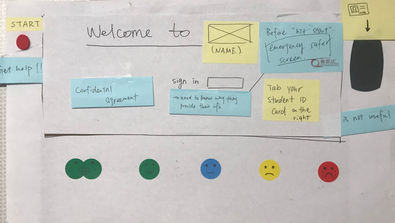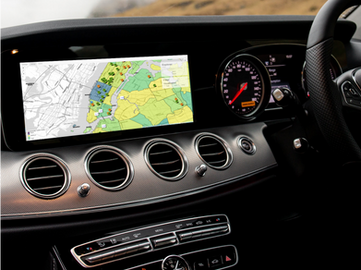
Welcome to the SupportRoom where you can get help.
Timeline
Oct 2018 - Dec 2018 (10 weeks)
My role
UX Designer
Design Tool
Sketch, InVision
Target user
Older teens to young adult female
Team
Greta Anderson (UX Designer)
Megan Rosseter (UX Researcher)
Angel Vuong (Product Manager)
Bobo Xu (UX Designer)

The problem: women need more support.
School safety issues draw our attention recently. Sometimes, the hurt is from your close relationship instead of a stranger. Most students, especially females, feel embarrassed, uncomfortable, or not safe to tell others, even they don't know what to do at that moment when they are violated.

"One of my guy friends grabbed my ass... Plz send help."
The experiences of one potential user who posted her story on Reddit especially catch our eyes. In this particular situation, they need help to feel safe to report and get support. This situation calls for a tool.
Our product is a UI kiosk on the school bathroom's wall aiming to provide a safe environment for female students to report the issue when they feel violated. There are two scenarios.
Emergency Scenario
Non-Emergency Scenario
"How to design an in-school tool to help a female student feel safe to report a situation where she felt violated?"

Enable to know more context to understand the problem space, we used four research methods to collect information. I was in charging of online student survey design.
What we learn
1
Teens struggle with peer pressure and how to communicate their needs in intimate relationships.
2
Teens fear rejection and being cheated on.
3
Teachers must walk a fine line in supporting teens through challenges in intimate relationships.
Our design principle also helped us aligned on our design goals.

Research

Online Student survey

Anonymous open-ended response survey

Parent & educator phone interview

Peers interview peers
Ideation
While conducting the research phase, we created personas to help us gain empathy for our target users. Each member came up with one persona, so did I.
Mari is our primary persona. She embodies several themes that we heard and read about from our research. The other three are secondary personas.
With our design principles and persona in mind, everyone collectively sketched six solutions for our design and favored the ideas that allowed for communication and reporting unsafe experiences.


My Sketches And Samples of the other members' idea
To pivot the ideas, we inspired by our interviews with a high school teacher revealed insight about students needing a safe space to retreat and seek immediate relief.
Bathrooms are the place in school where students can feel closed off, secluded, and private. Hence, we combined the strongest elements of our ideas and combined them into the SupportRoom.

The winning Idea
We began to have a clear idea of how the product solution might work. It was a submission tool in the bathroom that would be fast, secure, and responsive to report a violation.
We then bodystormed to think of scale and placement.
*Bodystorming is the idea that people imagine what it would be like if the product existed, and act as though it exists, ideally in the place it would be used. An example is shown on the right.

Bodystorming
We considered the flow of tasks that would support a female in her stressful state to submit a report and get the help she is seeking.

The prototyping helped synthesize what we learned and afterward, we felt aligned and united on the potential design solution. I developed a paper prototype that we could test with real users.

Paper Prototype Designed By Bobo
Prototype
Usability Test
We used paper prototype to test an emergency scenario and a non-emergency scenario with adult women in the class.

Results:
Overall the feedback was positive, and there was a greater sense of relief after experiencing a violation.
However, we need language around how to start a report. (Inclusivity)
Personal identification is not necessary to submit a report.
Anonymity may help build trust in the system. (Trustworthy)
We may need to create higher urgency options for true emergencies. (Time-sensitive)
After the feedback from the usability testing in class, we fixed our prototype and created a digital version - Mid-Fidelity Prototype.

For this time, in order to let our participants feel the real situation, we set the testing site in the bathroom across the campus with 5 young adult women.

 "Can I select more than one feeling?" |
|---|
Usability Test Session II
Results:
Participants expressed overall satisfaction with the “SupportRoom” tool. They felt the tool was supportive and useful. But our language was “too strong” and, perhaps, insensitive.
What we learn
Stress levels can be decreased after using the tool.
Users expressed a desire to use this tool.
Trust could be built with education and awareness of its intention.
It is easy to use and intuitive.
Users feel heard, seen, and loved after using it.
Evaluation
Our usability testings were successful and gave us insight on what areas to potentially work on, like language use, combining emergency and report buttons on the same screen, and gave us the encouragement to continue iterating because “[this] would be a great solution.”
What went well:
Solving for a real problem.
Participants felt that the tool was supportive, useful, easy to use and intuitive.
Diversity in users.
Challenges:
Finding users in the adolescent age group.
What we would do differently:
Update the "strong language" used in the design.
Strengthen our guiding design principles into the current school systems.
Therefore, we updated our final product design. (Video OR Interactive Prototype)
1) Friendlier language and connect with school (intuitive and integrated)

2) Create more visuals that create a caring and empathetic design

3) Iterate and test a consistent brand (Trustworthy)

Takeaways
From our prototype testing, we gained insights into ways to strengthen our guiding design principles of trust, reliability, time-sensitivity, inclusivity and integrating into the current school systems.
Empathy is one of our driving design principles.
Participants felt heard, seen, cared for and safe.
We would like to learn how we can optimize further. We want to explore visual design options, test language, try additional other scenarios with younger women, and better integrate with existing school systems.
Regarding to the female power, my favorite Japanese animtion Dragon Ball Z gives a good example. Even though the main characters are the strongest men in the universe, they are respectful and care about their wifes. The women characters are independent and strong as well. As we know, female right in Japan is very low. Most of them are housewife, they dedicate all their time and energy into the family.
Facebook operating officer Sherly Sandberg also writes the issue about female in work and recommendations in her book Lean In.
Therefore, not only report the issue and ask for help from the school, but we also need to strengthen our self-protection skill. I recommend school can offer the self-protection classeafter our product linking to school system,
Thank you for reading> <














